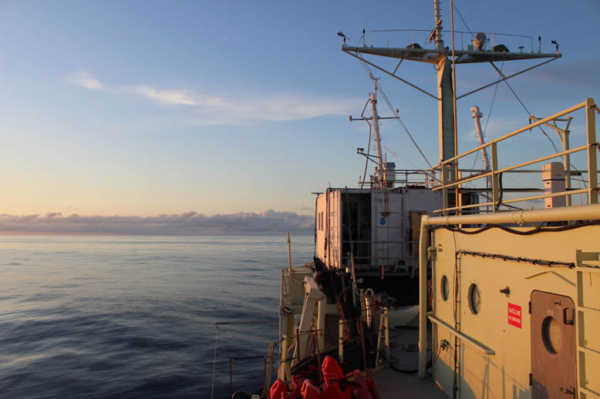Ambient and Sea Sweep Generated Aerosol Measurements in the North Atlantic in May-June 2014 during WACS2 (Western Atlantic Climate Study 2)
Ambient and Sea Sweep Generated Aerosol Measurements in the North Atlantic in May-June 2014 during WACS2 (Western Atlantic Climate Study 2)
About this collection
- Extent
-
1 digital object.
- Cite This Work
-
Sanchez, Kevin J.; Russell, Lynn M.; Zoerb, Matthew C.; Kim, Michelle J.; Massoli, Paola; Bertram, Timothy H.; Bates, Timothy S.; Quinn, Patricia K. (2017). Ambient and Sea Sweep Generated Aerosol Measurements in the North Atlantic in May-June 2014 during WACS2 (Western Atlantic Climate Study 2). UC San Diego Library Digital Collections. https://doi.org/10.6075/J0M61HFH
- Date Collected
- 2014-05-20 to 2014-06-05
- Date Issued
- 2017
- Principal Investigators
- Researchers
- Methods
-
The second Western Atlantic Climate Study (WACS2) was conducted in the northwest Atlantic on the R/V Knorr from 20 May to 5 June 2014. A Sea Sweep was used to generate primary marine aerosols at five stations with a range of chlorophyll-a concentrations. Station 1 and 3 are located at approximately the same location in intermediate chlorophyll-a waters about 900 km east of Long Island (40°N, 62°W), station 2 is located in eutrophic waters about 1800 km west of Boston (42.5°N, 61.5°W), station 4 is located in oligotrophic waters 200 km northwest of Bermuda in the Sargasso Sea (33.5°N, 63°W), and station 5 is located in coastal waters 130 km south of Cape Cod (40.5°N, 70.5°W). Particles were generated in the ocean, free of ambient air contamination, and transported to the aerosol particle sampling vans on the R/V Knorr. Ambient particles were collected with a temperature controlled vertical inlet at ~15 m above sea level. Ambient aerosols were measured directly with the aerosol inlet [Betha et al. 2017] between stations and during strong winds or large waves that prevented the safe deployment of the model ocean system.
Ambient and sea sweep particles were dried before submicron particles were separated from supermicron particles with a 1 µm cut cyclone (sharp cut cyclone SCC 2.229 BGI Inc., U.S.) then analyzed with a high-resolution time-of-flight aerosol mass spectrometer (HR-ToF-AMS, Aerodyne Research Inc., Billerica, MA) to measure non-refractory inorganic (sulfate, ammonium, nitrate, chloride) and organic components [DeCarlo et al., 2006], and refractory sea salt and a soot-photometer time-of-flight aerosol mass spectrometer (SP-ToF-AMS, Aerodyne Research Inc.) that also measured refractory black carbon. The HR-ToF-AMS included a light scattering mode (LS-AMS) to analyze the composition of individual particles. The LS-AMS had a lower cut off diameter of 400 nm.
Ambient and sea sweep marine particles were collected on pre-scanned 37 mm Teflon filters (Pall Inc., 1 µm pore size) for 4-24 hours. Before aerosols were collected on the filters, the particles were dried in diffusion driers and passed through either the 1 µm cut cyclone (SCC) or a 1.1 µm cut Berner impactor. Filter samples were frozen and then analyzed in the lab with Fourier transform infrared (FTIR) spectroscopy (Tensor 27 spectrometer, Bruker, Billerica, MA). The generated marine samples were dehydrated using the method outlined by Frossard and Russell [2012] to remove interference of sea salt hydrate bound water with the organic signal in the FTIR spectra. The FTIR spectrum from each filter was baselined and integrated at specific peak locations to determine the peak areas of the organic functional groups using an automated algorithm outlined by Maria et al. [2002] and revised by Russell et al. [2009] and Takahama et al. [2013].
Dry ambient aerosol particle size distributions were measured with an Aerodynamic Particle Sizer (APS 0.5–20 μm Dp; TSI, Shoreview, Minnesota, model 3321) and an Optical Particle Sizer (OPS 0.3–10 μm Dp; TSI). A TSI model 3010 Condensation Particle Counter (CPC) measured total submicron particle concentration.
A miniature chemical ionization mass spectrometer (miniCIMS) utilized benzene cation reagent ion chemistry to permit the detection of dimethyl sulfide, isoprene, and monoterpenes. Waterside concentrations were determined by sampling the headspace of a seawater equilibrator attached to the ship underway seawater supply. - Geographic
- Topics
Formats
View formats within this collection
- Language
- No linguistic content; Not applicable
- Related Resources
- Sanchez KJ, Chen CL, Russell LM, Betha R, Liu J, Price DJ, Massoli P, Ziemba LD, Crosbie EC, Moore RH, Müller M, Schiller SA, Wisthaler A, Lee AKY, Quinn PK, Bates TS, Porter J, Bell TG, Saltzman ES, Vaillancourt RD, Behrenfeld MJ (2018). Substantial Seasonal Contribution of Observed Biogenic Sulfate Particles to Cloud Condensation Nuclei. Nature Scientific Reports. https://doi.org/10.1038/s41598-018-21590-9
- Data also at NOAA Pacific Marine Environmental Laboratory: https://saga.pmel.noaa.gov/data/PrePlot.php?cruise=WACS2014
Primary associated publication
Other version
 Library Digital Collections
Library Digital Collections
